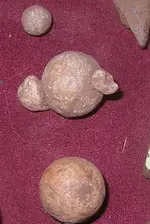Ihatepoisonivy
Full Member
- Joined
- Feb 22, 2013
- Messages
- 229
- Reaction score
- 264
- Golden Thread
- 0
- Primary Interest:
- All Treasure Hunting

...and glad you are Mr.CBG,as does everybody else!The "bigger" bullet is definitely a Williams' Patent .58 -caliber Type 3 "bore-cleaner" bullet -- which is strictly a yankee-made bullet. The small lead ball is most probably a buckshot ball.
I suspect you already know the button is a yankee "general service" button for Enlisted-men (non-officers). For any readers here who don't know, the very thin stamped-brass buckle is a kepi-hat's chinstrap adjuster buckle. And Bryanhashemi is right, the small disc with a round hole through the center is from a grommet or rivet.
Edit: Ihatepoisonivy and Kuger and I were typing our replies at the same time. I'm just more "wordy" than they are.
Educational info for any reader who doesn't already know...
Definition of the term "Buck-&-Ball" ammunition, intended for use in civil war (and earlier) muzzleloader smoothbore muskets, meant it contained one "fullsize" (such as .69-caliber) lead musketball (the "ball") and three smaller lead balls (the "buck," meaning buckshot).
There was also simple Buckshot ammo, which contained just the small balls (12 or more per shot).
I've used a Digital Caliper to precisely measure the theee "buck" which I've dug in the same hole with a .69-caliber ball. The three "buck" in a .69-caliber Buck-&-Ball load were .31 to .32-inch in diameter. Smaller Buck-&-Ball ammo also existed (such as .58-caliber), whose buck-balls were appropriately smaller in diameter, about .28-inch.

